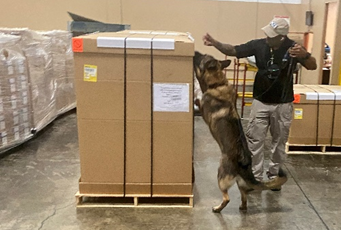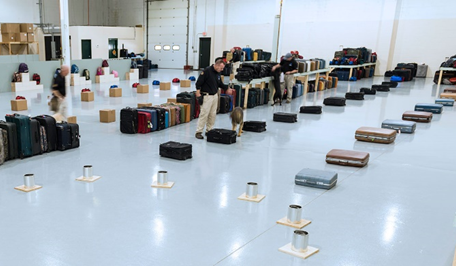Dogs have an incredible sense of smell, with up to 300 million olfactory receptors in their noses, compared to about six million in humans. And the part of a  dog's brain that is devoted to analyzing smells is about 40 times greater than ours. Most canines enjoy a “job” that keeps their bodies busy and their brains occupied – which is one reason why they make terrific bomb dogs. When it comes to work like this, once a dog understands that their task is to find a certain scent in exchange for a reward such as food or a toy, look out. The eagerly take on the task with endless gusto.Handler and Canine in Training CenterSpeaking of enthusiasm, meet Enhanced Protection Services Explosive Detection Canine Team Eliezer Ramirez Sanchez and Quincy IV. Last month’s Bomb Dog Spotlight highlighted their important work screening air cargo in Puerto Rico. There are more than 800 teams in Enhanced Protection Services’s Explosive Detection Canine Program, an Allied Universal® Solution, working across the globe to deter and detect the rising threat of improvised explosive devices (IEDs). Sports and entertainment venues, public transit hubs, cargo facilities, landmarks and commercial buildings are just some of the many high-profile targets terrorists eye.
dog's brain that is devoted to analyzing smells is about 40 times greater than ours. Most canines enjoy a “job” that keeps their bodies busy and their brains occupied – which is one reason why they make terrific bomb dogs. When it comes to work like this, once a dog understands that their task is to find a certain scent in exchange for a reward such as food or a toy, look out. The eagerly take on the task with endless gusto.Handler and Canine in Training CenterSpeaking of enthusiasm, meet Enhanced Protection Services Explosive Detection Canine Team Eliezer Ramirez Sanchez and Quincy IV. Last month’s Bomb Dog Spotlight highlighted their important work screening air cargo in Puerto Rico. There are more than 800 teams in Enhanced Protection Services’s Explosive Detection Canine Program, an Allied Universal® Solution, working across the globe to deter and detect the rising threat of improvised explosive devices (IEDs). Sports and entertainment venues, public transit hubs, cargo facilities, landmarks and commercial buildings are just some of the many high-profile targets terrorists eye.
The Most Efficient and Effective Explosive Screening Solution
It is widely acknowledged that canines are the most capable, effective and efficient method for real-time detection of explosives in a variety of environments. In fact, Popular Science reported that after $19 billion was spent over six years, the Pentagon concluded that the best bomb detector is a dog. This understanding has led to a worldwide increase in their use across the private and government sectors. Will any canine suffice for this very critical job? The simple answer is no. Only a properly imprinted and trained canine meets the highest-level performance expectations and provides optimal field experience in detecting explosive borne threats – regardless of how the threat is presented. To meet rigorous standards, Enhanced Protection Services’s successful EDC Program is rooted in a proven 6-phase philosophy.

- Canine Procurement: A strict vetting process selects only from best-in-class sporting and herding breeds with a keen sense of smell, strong drive, intelligence, stable temperament and eagerness to please. Dogs must also possess a significant level of existing socialization, which accelerates the training process and yields better results.
- Canine Imprintation: The training at one of Enhanced Protection Services’s seven nationwide training facilities centers around imprinting dogs all five families of commercial explosives, as well as homemade explosives (HMEs) like TATP and HMTD. Explosive odors are never “cocktailed” which maximizes olfactory recognition in the field.
- Handler Training: An EDC team is as effective as the relationship between the canine and handler. Single-purpose, single-handler teams build and continue to reinforce that special work bond. The third phase of training introduces this strong working partnership and provides handlers with the necessary tools for success.
- Joint Operational Training:
 This is the specialty phase of training where handler and canine focus on their intended deployment. Teams train at one of Enhanced Protection Services’s training academies, located in several major metropolitan areas nationwide. Addressing both mobile and stationary explosive odors, specialty training modules include: (1) Explosive Odor Tracking, (2) Explosive Cargo Screening, (3) Loading Dock Screening, (4) Checkpoint Screening, (5) Public Transportation Area Screening and (6) Ammunition and Firearms Screening.
This is the specialty phase of training where handler and canine focus on their intended deployment. Teams train at one of Enhanced Protection Services’s training academies, located in several major metropolitan areas nationwide. Addressing both mobile and stationary explosive odors, specialty training modules include: (1) Explosive Odor Tracking, (2) Explosive Cargo Screening, (3) Loading Dock Screening, (4) Checkpoint Screening, (5) Public Transportation Area Screening and (6) Ammunition and Firearms Screening. - Testing and Certification: Successful EDC programs are consistently evaluated through independent testing and certification on nationally recognized NAPWDA standards. While not a requirement, Enhanced Protection Services also chooses to annually administer the Department of Justice National Odor Recognition Test (DOJ NORT) certification for all teams.
- Sustainment Training: Explosive threats are always evolving and bad actors continue to adjust their tradecraft and choice of weapons. Providing today’s handlers with the right tools requires ongoing education taught by experienced bomb technicians to ensure handlers are always ready for real-life, real-threat scenarios.
The average person attending a sports event, visiting a landmark or traveling through a transit hub may take quick notice of an EDC team on the move without much thought. Their discrete presence is by design to help maintain comfort and peace of mind for the public. Completing the demands of rigorous EDC training protocols, handlers and their tail-wagging partners are well prepared and carry the extraordinary skills required to keep the public safe.









